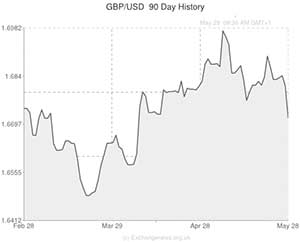
The Pound to US Dollar exchange rate (GBP/USD) is currently trading at its lowest level since mid-April.
Sterling tumbled from 1.6880 to 1.6800 on Tuesday as soft British housing market figures proved detrimental to the UK currency. The Pound fell by a further cent to 1.6700 yesterday as investors digested a weaker-than-anticipated UK retail sales report from the Confederation of British Industry (CBI).
GBP/USD began this holiday-shortened week badly on Tuesday when the British Bankers’ Association (BBA) announced that loans approved for house purchases slowed from 45,045 to 42,173 in April. Later in the day ‘Cable’ succumbed to further losses as US consumer confidence ticked higher from 81.7 to 83.0 and Markit’s composite PMI of total private sector output jumped to 58.6 – its highest level since April 2010.
Sterling continued to weaken through yesterday’s session as the CBI’s retail sales index plunged from +30 in April to +16 in May, confounding expectations of +35. It is thought that sales volumes dropped in May following strong gains in April related to the Easter holiday. The disappointing data sent GBP/USD plunging through psychological support at 1.6800 and the Pound fluctuated lower towards 1.6700 throughout the day as investors began to question whether Sterling’s 6-month bull run against the US Dollar could be about to end.
Since failing to breach longstanding technical resistance at 1.7000 on May 6th the Pound has weakened by around three cents. This suggests that GBP/USD may have already topped out.
Later today we will find out how well (or badly) the US economy performed during the first quarter. The first estimate of Gross Domestic Product suggested that on an annual basis the world’s largest economy managed to squeeze out a minimal expansion of 0.1%. However, this afternoon’s revision is predicted to see US Q1 GDP downgraded to show an annualised shrinkage of -0.5%.
This will mark the first contraction since the Q1 of 2011 and could have a negative impact on demand for the ‘Greenback’.
However, Federal Reserve Chairwoman Janet Yellen is aware of the possible slowdown in growth and she does not seem overly concerned. Speaking earlier in the month at her congressional testimony Yellen said:
“Although real GDP growth is currently estimated to have paused in the first quarter of this year, I see that pause as mostly reflecting transitory factors, including the effects of the unusually cold and snowy winter weather. With the harsh winter behind us, many recent indicators suggest that a rebound in spending and production is already under way, putting the overall economy on track for solid growth in the current quarter”.
Subsequently, it is possible that traders may not punish the US Dollar for the poor performance of the US economy during the first quarter. If US GDP is negatively revised but GBP/USD does not spike it will strengthen the argument for further Sterling losses.
If GBP/USD’s bullish trend line is broken then it could lead to a period of weaker Pound to US Dollar exchange rates.

Comments are closed.